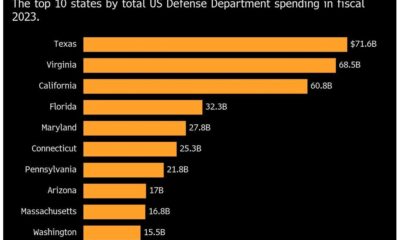Business
Canada Faces Economic Contraction as Exports Plummet Under Tariffs

Canada’s economy experienced a contraction for the first time in over a year, driven by new tariffs imposed by the United States and a decline in global demand. According to a report from Statistics Canada, the country’s real gross domestic product (GDP) fell by nearly 0.4 percent in the second quarter of 2025. This downturn marks a significant shift following six consecutive quarters of economic growth.
The decline in GDP is closely linked to a sharp drop in exports, which decreased by 7.5 percent in the same quarter. The implementation of tariffs on crucial Canadian goods, such as steel, aluminum, and automobiles, has significantly affected trade dynamics. These tariffs, imposed under the guidelines of the Canada-United States-Mexico Agreement (CUSMA), have compounded existing challenges in international markets.
Impact on Manufacturing and Employment
The report highlighted that the current economic slump is the largest quarterly decline since 2009, excluding the period of the COVID-19 pandemic. The repercussions extend beyond just export figures; manufacturing, wholesaling, and employment have also experienced setbacks. Businesses involved in cross-border trade are actively seeking strategies to mitigate the disruptions caused by these tariffs.
In May, 54 percent of manufacturers and 44 percent of wholesalers reported being impacted by the tariffs. The labor market has not seen net employment growth from February to August of this year, with a noticeable deceleration in public sector job creation. The private sector has been particularly vulnerable, experiencing growth rates below two percent for the past 17 months.
A significant portion of the business community has begun to pass on the increased costs resulting from tariffs to consumers. Approximately 33 percent of businesses reported doing so in the last six months, while 40 percent indicated they are likely to follow suit within the next year.
Consumer Goods Prices on the Rise
As tariffs continue to influence the market, consumer goods prices are feeling the pressure. Items such as new cars, clothing, household appliances, and various grocery products have been impacted by both U.S. tariffs and Canada’s countermeasures. This economic environment is causing concern among consumers, who may find themselves facing higher prices in the coming months.
The findings from Statistics Canada not only reflect the current state of the economy but also signal potential long-term effects if trade relations do not improve. As businesses grapple with these challenges, the Canadian economy must navigate a path toward recovery, addressing both domestic and international pressures.
-

 World3 months ago
World3 months agoScientists Unearth Ancient Antarctic Ice to Unlock Climate Secrets
-

 Entertainment3 months ago
Entertainment3 months agoTrump and McCormick to Announce $70 Billion Energy Investments
-

 Lifestyle3 months ago
Lifestyle3 months agoTransLink Launches Food Truck Program to Boost Revenue in Vancouver
-

 Science3 months ago
Science3 months agoFour Astronauts Return to Earth After International Space Station Mission
-

 Technology2 months ago
Technology2 months agoApple Notes Enhances Functionality with Markdown Support in macOS 26
-

 Top Stories2 weeks ago
Top Stories2 weeks agoUrgent Update: Fatal Crash on Highway 99 Claims Life of Pitt Meadows Man
-

 Sports3 months ago
Sports3 months agoSearch Underway for Missing Hunter Amid Hokkaido Bear Emergency
-

 Politics3 months ago
Politics3 months agoUkrainian Tennis Star Elina Svitolina Faces Death Threats Online
-

 Technology3 months ago
Technology3 months agoFrosthaven Launches Early Access on July 31, 2025
-

 Politics3 months ago
Politics3 months agoCarney Engages First Nations Leaders at Development Law Summit
-

 Entertainment3 months ago
Entertainment3 months agoCalgary Theatre Troupe Revives Magic at Winnipeg Fringe Festival
-

 Politics2 weeks ago
Politics2 weeks agoShutdown Reflects Democratic Struggles Amid Economic Concerns



















